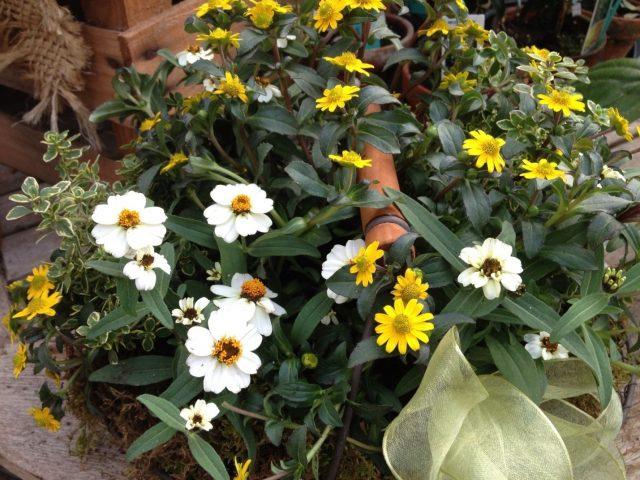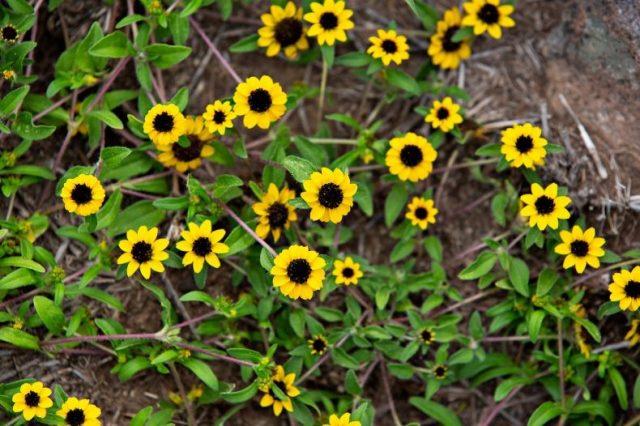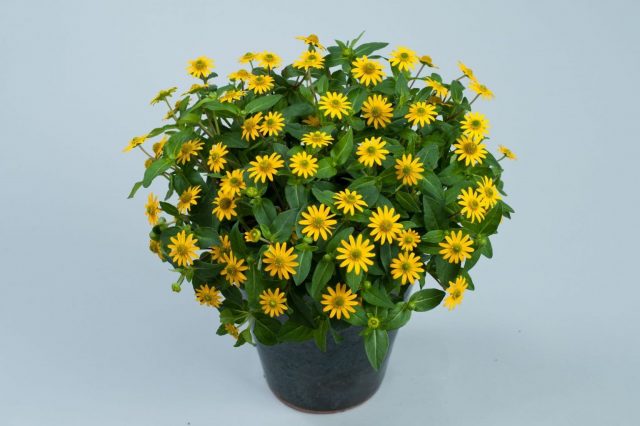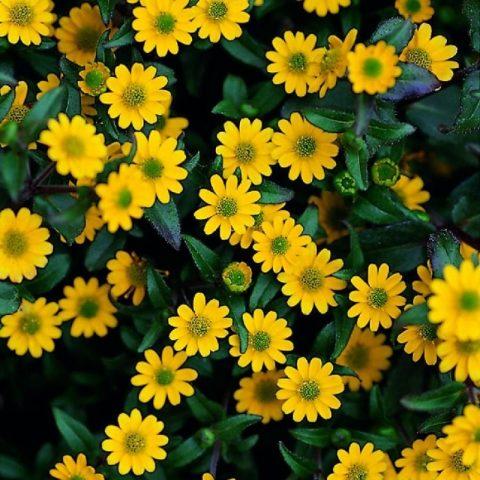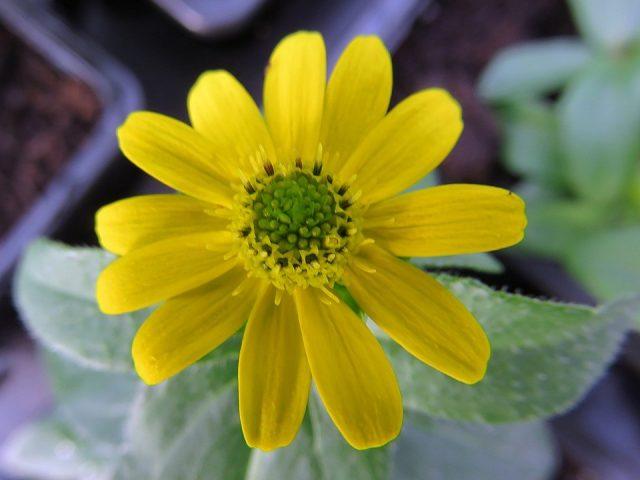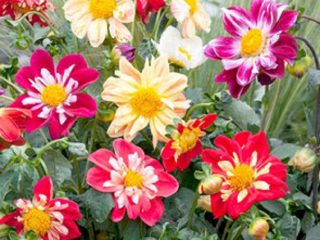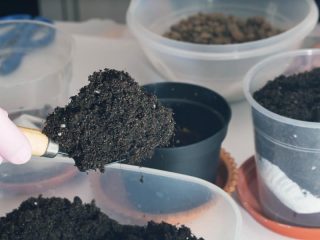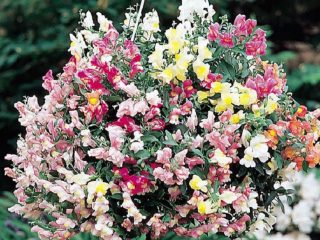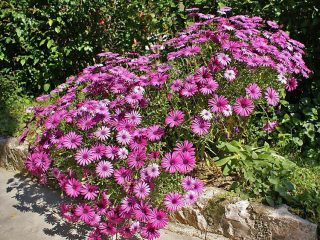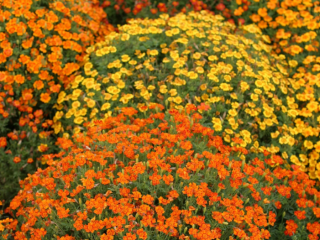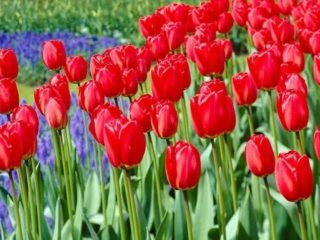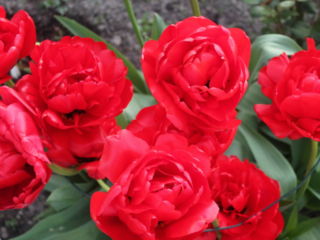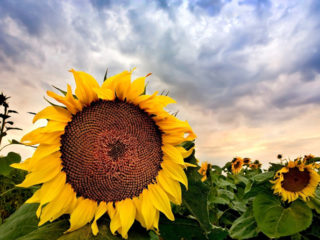Content
- 1 What does a sanvitalia flower look like?
- 2 Useful properties of sanvitalia
- 3 Types and varieties of sanvitalia
- 4 Growing sanvitalia from seeds at home
- 5 Planting seedlings in the ground
- 6 Caring for sanitation in open ground
- 7 Pests and diseases
- 8 Application in landscape design
- 9 Conclusion
- 10 Reviews about sanvitalia
Photos and descriptions of Sanvitalia will help the gardener understand what kind of plant it is, how to grow it and what to combine it with in the garden. This flower resembles a sunflower in appearance, only in a greatly reduced version. He is able to add variety to compositions and decorate different flower beds. Sanvitalia is distinguished by its long flowering until frost.
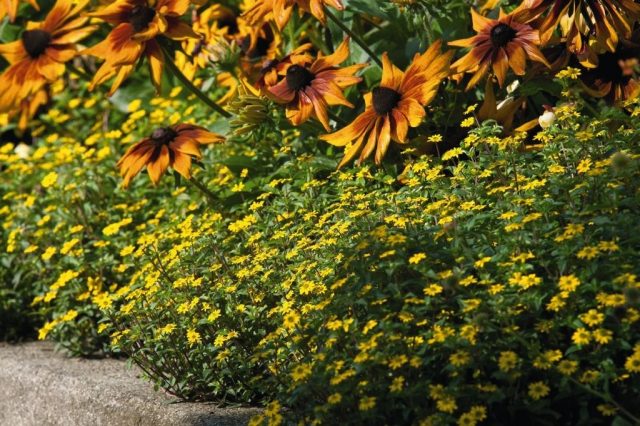
There are many varieties of sanvitalia, differing in characteristics and shades
What does a sanvitalia flower look like?
Sanvitalia is a flower of the Compositae family, bushy but not tall, on average the length of its stems is 30-35 cm (maximum 0.5 m). The plant has flexible, creeping and branching shoots that rise above the soil surface by no more than 15 cm.
The leaf plates of the sanvitalia flower are dark green, have an ovoid, elongated shape, and are located opposite. The flowering of the crop is abundant, the inflorescences are represented by baskets with a diameter of about 3 cm.Their color depends on the variety and can be yellow, white, orange and even purple. Sanvitalia buds begin to appear on the bushes closer to July. The flower grows rapidly, in good conditions it forms a lush carpet in the flowerbed, and in pots it looks like a hanging dense cascade.
The culture began to be used in the 18th century, but it began to be actively included in flower arrangements about 10-15 years ago. It is a perennial, but some gardeners grow it as an annual plant.
Useful properties of sanvitalia
Sanvitalia is a wonderful decorative flower, the use of which is to decorate the landscape, as well as to transform balconies and terraces. This is an excellent hanging and ground cover crop, almost universal in use.
The flower is planted:
- in mixborders, flower beds, rockeries, alpine slides;
- along garden paths;
- in open areas as a ground cover;
- as a decorative spot on the lawn;
- in hanging flowerpots;
- on balconies and in window boxes.
Types and varieties of sanvitalia
In nature, there are seven species of sanvitalia flowers known, from which, thanks to the work of breeders, several dozen ornamental varieties have appeared. Although only a couple of them can be found in cultivation.
The most common variety cultivated in Russian cities is Sanvitalia procumbens. It is quite tall, can grow up to 30 cm. It is characterized by numerous basket-shaped flowers from yellow to orange in color with tubular centers. Most varieties are simply yellow.
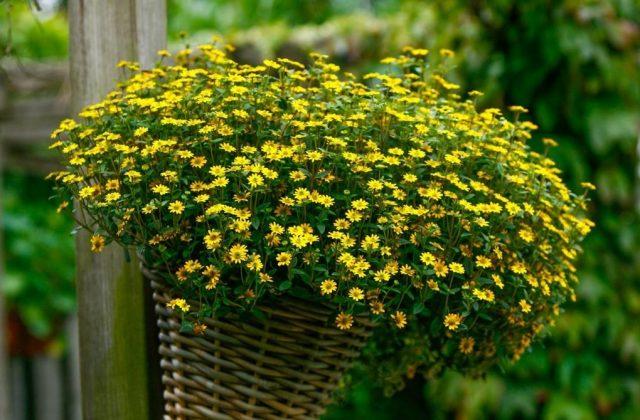
The common sanvitalia flower is considered a popular balcony variety
Another type of crop found in the garden is Sanvitalia speciosa. It grows up to 25 cm and is distinguished by its rounded bush shape. The color of flower buds depends on the variety.
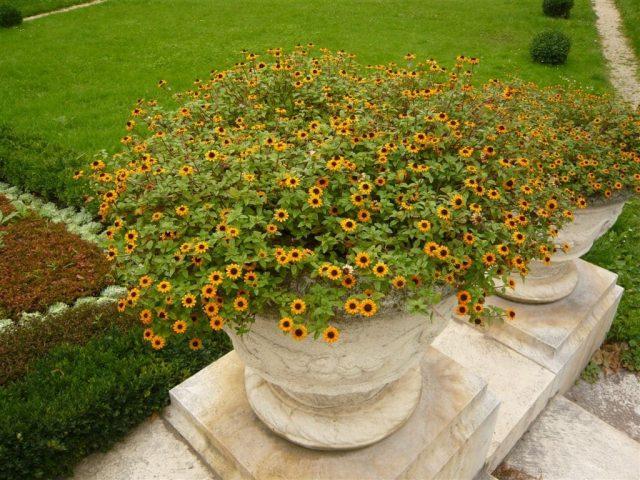
Most often, beautiful sanvitalia blooms with yellow buds with a green core
Of the most common plant varieties, it is worth highlighting:
- Gold Braid is a sanvitalia with branched creeping shoots. Short. Its flowers are small, persist until late autumn, and appear on the bushes four weeks after planting.
Gold Bright height is about 20 cm
- Sprite - sanvitalia up to 35 cm high. With creeping, reddish shoots. There are many flowers on it, they are small, orange-yellow or just yellow.
The central part of the flower of the Spirite variety is brown and convex
- Inca Yellow is a variety with erect stems. Characterized by a compact shape. The flowers are small, in yellow tones.
Insa Yellow looks great in flowerpots and tall planters
- Million Suns is an ampelous sanvitalia (photo below). Characterized by uniform growth and good branching. The stems of the crop are semi-hanging.
The flowers of the variety are small, yellow in color
- Santiago Bright Yellow is a variety with very high resistance to hot weather. It differs from others in its large flowers.
Santiago Bright Yellow has increased durability
Growing sanvitalia from seeds at home
Sanvitalia is an annual and perennial; its cultivation usually begins with sowing seeds at home. The procedure is not entirely simple and requires time and effort, and also requires strict adherence to care rules.
Sanvitalia loves light very much and is considered an ideal plant for a sunny balcony. It will grow in shaded places, but flowering will become less spectacular and the shoots will become longer. The flower reacts poorly to a sudden change in temperature, and when it drops to negative, it dies.
When to plant sanvitalia seedlings
Sanvitalia seeds are usually planted in mid-April. Previously, it is undesirable to do this, since seedlings are very sensitive to even a slight drop in temperature.
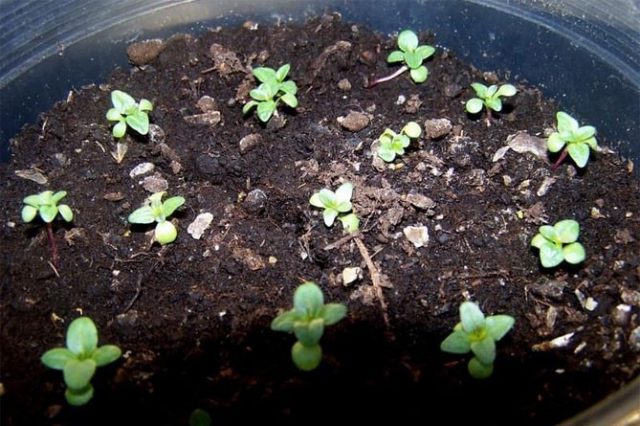
Sanvitalia planted with seedlings blooms in June, and when sown in open ground - in August
Rules for sowing sanvitalia seeds for seedlings
To plant crops, take low but wide containers and fill them with drained, nutritious and moisture-absorbing soil, preferably mixed with sand 2:1. Then the seeds are distributed evenly over the surface of the earth. Due to their small size, they should not be buried; simply sprinkle them with a small amount of substrate. Next, sprinkle with water and cover with cellophane or glass to create a greenhouse effect, put it on a sunlit window sill in a room with a temperature of +18-20 ° C. Every day, containers with plantings are ventilated and, if necessary, the soil is moistened.
Seedling care
After the sanvitalia sprouts appear on the surface of the earth, the cover is removed from the boxes, the temperature in the room is lowered to +15 ° C and care of the plantings begins.Watering is carried out by drip method, as the soil dries out approximately every four days.
When two pairs of true leaves appear on the seedlings, sanitation will need picking. It is transplanted into separate containers of 2-3 pieces, placed in a well-lit place, protected from drafts, with a temperature of +20 ° C.
Another rule of care is that sanvitalia seedlings need to be pinched. They do this twice. Thanks to the procedure, the seedlings become more compact and begin to branch better.
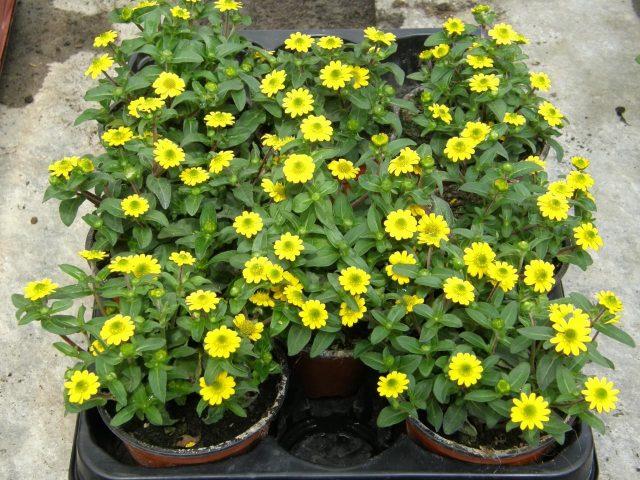
Flower seeds remain viable for two years
Planting seedlings in the ground
They begin to plant the crop in open ground when the threat of return of frost has completely passed and the daytime temperature remains at +20 °C. Sanvitalia seedlings should look healthy, strong, and be hardened.
The flower sprouts are moved into pre-prepared holes with a depth of 10 cm and a diameter of about 7 cm. It is advisable to pour a layer of drainage at the bottom of each hole. The distance between planting holes must be at least 25 cm; when growing in pots, an interval of 10 cm is allowed.
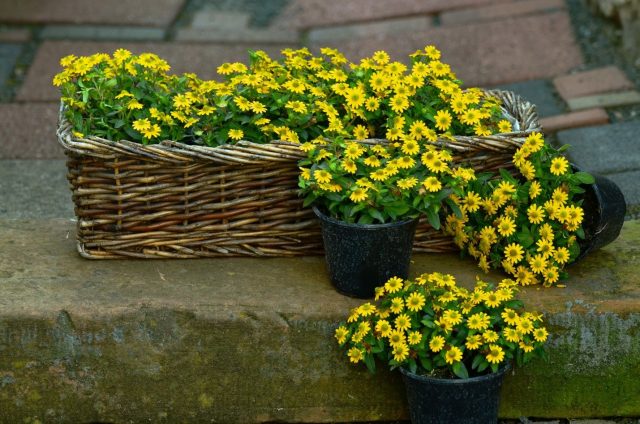
Adult bushes of the sanvitalia flower are strong, they can be transplanted even in a blooming state
Caring for sanitation in open ground
Growing sanvitalia is not difficult; it grows well on rocky and even depleted soils, as long as the area is sunny. Although, to increase the decorativeness of the flower, it is useful to add complex mineral fertilizers to the soil.The first time at the beginning of the growing season, the second time in the last week of August.
Water the flower in open ground once a week, and more often when kept in pots. If the crop does not have enough water, it will begin to dry out and its leaves will begin to curl. In case of excess moisture, the roots of sanvitalia begin to rot.
Another rule when caring for a crop is the removal of faded buds. Also, to increase the bushiness of the flower, you can pinch the shoots. If, on the contrary, the plant has grown greatly, then it can be pruned, removing up to 70% of the shoots.
Pests and diseases
With proper care, the sanvitalia flower is resistant to diseases and pests, but if the bushes are overwatered, they are exposed to rot. In addition, if there is excessive humidity or dense planting, the bush is susceptible to a fungal infection - blackleg.
Application in landscape design
The sanvitalia flower has a wide range of uses. The plant looks impressive in the design of multi-tiered cascading flower beds and in container plantings. It can be combined with almost all crops, especially annuals. Flowerbeds with sanvitalia and iberis, forget-me-nots, brilliant sage, nasturtium look very gentle; it harmonizes with alyssum, verbena, and petunias. The flower looks great along paths and between stones, quickly grows in width, filling all the gaps that remain after faded primroses.
Due to its creeping shape, the sanvitalia flower is used in the landscape as an hanging crop and is grown in pots and boxes. When planted in this way, it is often combined with lobelia erinus, ashy ragwort, heliotrope, immortelle, coleus, and lantana.
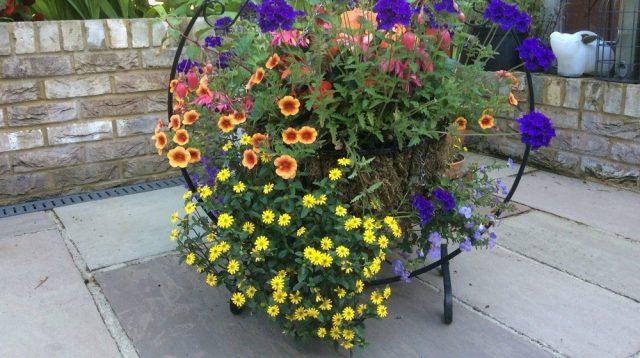
The sanvitalia flower serves well as a border
Conclusion
Photos and descriptions of sanvitalia give a complete picture of this culture. It goes well with many flowers, feels great indoors, and can grow in almost any area. Small and undemanding to growing conditions, it will serve as an excellent decoration for the landscape of a garden, terrace or balcony. It is not difficult to grow; even a novice gardener can handle planting it.
Reviews about sanvitalia
